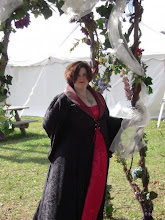
On December 4, I took a PTO day from work and along with my absolutely beloved mom, we took the train into The City. Of course here in CT, when I refer to 'The City', we understand it to me
an New York City. The train ride into NYC is my preferred method of transportation and this trip was no exception. Grand Central was awesome as usual and this was my mom's first time since we moved here from Missouri 16 years ago. This trip has a first for me as well - I have never taken a taxi in NYC before. The first cab driver we got was Yu Chow and he was amazing. My mom started to talk to him and he seemed delighted and eager to answer any questions she may have. He even took
a more difficult route through the city so that we could pass the Rockefeller Christmas Tree on our way to the museum. He pointed out famous places like Saks Fifth Avenue, Radio City Music Hal and the NBC Studios. I have been to these places all before, but my mom was thrilled. With my first taxi cab ride over, we stood outside the entrance to one of the largest museums in the world.

If it was not for a friend of mine who explained the entrance price to me, I would have paid $20 per ticket as is recommended. She advised that we could put a quarter on the desk and they would take that. Since we were splurging on this mother/daughter outing to the big city, I pulled the first bill I had in my wallet and put it on the desk. I am very appreciative that a museum of this caliber and size can accommodate the rich and the poor so that everyone can see its treasures.
I took over 200 pictures in 45 minutes. I could spend days trying to make sure that I saw everything single piece on display, but our time was limited so I focused on the areas of my
personal interests; Egyptian, Medieval and Renaissance. Let me start with Egyptian as this is where my tour through the museum also began...




Once we reached the famed book of the dead, which I could not capture all of it on a single frame and was not allowed to video tape it, my mom took a rest and I went off in search of Medieval art. I found the Greek and Roman section which led to African and South American art which led into Renaissance. Here, I decided to go window shopping for furniture in my house.

This will be in my foyer

This will be my parlor

This will be my dining room
and this gorgeous example of French design in the Renaissance era...

will be my bed :)
I finally found my holy grail - Medieval Art. I was in history heaven and wanted to capture everything I saw. Here are the highlights of my favorite pieces...

These are pieces that were part of a personal or family shrine

This was a gorgeous stone and marble table - unfortunately the decoration on the top of the table did not come out well on the camera

This is a beautifully detailed metal box

This was part of the Medival Arms section. Seeing the suits of amour for both man and horse situated in this fashion was breathtaking for me - I'm into this stuff.
This last photo is of the Christmas tree that is in the great hall as part of the medieval exhibit. There were so many people around I could not take more than one photo of the tree so unfortunately I did not get any close up shots of the ornaments and decorations surrounding the base of the tree. It was amazing.

 On that bright, sunny Saturday after Thanksgiving, I decided to visit both the Yale Art Gallery and the Yale Center for British Art. The British Art museum was the second stop on my agenda. It was conveniently located across the street from the Yale Art Gallery (and across from a Starbucks too :-D). On street parking is very limited since it is a city, but parking in the Chapel-York Street garage was not a bad alternative. The outside of the building isnt anything to write home about - or in our case to blog about. Simply looks like an office building from the 1970s to me. What I liked though about the outside of the building was that you could see some of the pieces from the street.
On that bright, sunny Saturday after Thanksgiving, I decided to visit both the Yale Art Gallery and the Yale Center for British Art. The British Art museum was the second stop on my agenda. It was conveniently located across the street from the Yale Art Gallery (and across from a Starbucks too :-D). On street parking is very limited since it is a city, but parking in the Chapel-York Street garage was not a bad alternative. The outside of the building isnt anything to write home about - or in our case to blog about. Simply looks like an office building from the 1970s to me. What I liked though about the outside of the building was that you could see some of the pieces from the street. 



































